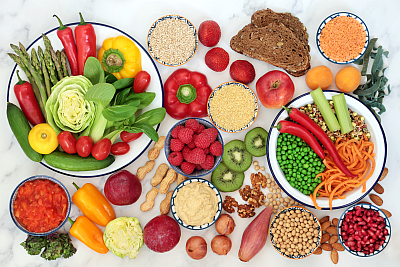As part of our work with the American Heart Association, our dietitians and chefs often share their insights and ideas for healthier living. Good nutrition is one of the most important steps we can take towards lowering the risk of chronic diseases like heart disease, high blood pressure and—the main focus of this blog—diabetes.
Diabetes is a condition that affects more than 30 million Americans. To help prevent diabetes, or to help manage it for those already living with the disease, a strong understanding of good nutrition is especially important. But first, what is diabetes, and what does it have to do with a healthy lifestyle?

“As common as it is, diabetes is not well understood by many people,” says Joanne DeRobertis, an Aramark Registered Dietitian Nutritionist who specializes in the disease. “Because diabetes is so intertwined with food and nutrition, it certainly can be confusing.”
We asked Joanne to help share her knowledge about the most prevalent form, type 2 diabetes.
What is type 2 diabetes and how does it affect the body?
Joanne: First off, it helps to know about insulin. This hormone, made by your pancreas, helps unlock energy from the food you eat and get it into your cells.
Diabetes happens when your body either cannot produce enough insulin, or just doesn’t respond to insulin the way it should (which is called insulin resistance). Over time, high blood glucose (or blood sugar) can damage your eyes, nerves, heart and more.
Type 2 diabetes accounts for 90 to 95 percent of diagnosed diabetes cases in the United States.
Who is at risk for developing type 2 diabetes?
Joanne: Experts are still learning exactly how type 2 diabetes develops, but we do know who is likely to get it. Generally, you’re at higher risk if you:
- Have prediabetes (when your blood sugar is above normal but not high enough to be type 2)
- Are overweight or obese
- Are 45 years or older
- Have a parent, brother, or sister with type 2
- Are physically active less than three times a week
- Have a history of gestational diabetes, or given birth to a baby weighing more than 9 pounds
- Are an African American, Hispanic/Latino American, American Indian, or Alaska Native (some Pacific Islanders and Asian Americans are also at higher risk)
It’s important to know that you may not have any symptoms with prediabetes or even early type 2 diabetes. So if you have any of these risk factors, be sure to talk to your doctor about getting tested.

How can people prevent type 2 diabetes?
Joanne: The good news is that type 2 diabetes in many cases can be prevented or delayed with healthy lifestyle choices. I usually have four main recommendations:
#1: Follow a healthy diet. Good nutrition is beneficial for everyone, and it is especially important for preventing and managing type 2. No one food can prevent diabetes—so think big-picture here.
- Your body and brain need carbohydrates for energy, but carbs will also raise your blood sugar. Make them count: Choose whole grains over refined grains and other highly processed carbohydrates. Fruits, vegetables and legumes are also good sources of “good” carbs.
- Drink more water and skip sugary beverages like regular soda, sports drinks, and sweet tea. Those are empty calories, and bad news for your blood sugar.
- Choose healthy fats like olive, safflower, canola, corn, sunflower, and peanut oils. Avoid tropical oils.
- Limit red processed meats. Instead, go with lean proteins like chicken, turkey, fish, beans, or nuts.
#2: Get up and get active! Exercise plays a major role in preventing and controlling prediabetes, gestational diabetes, and type 2 diabetes.
- Aim for 150 minutes per week of moderate-intensity aerobic activity, like walking or playing a team sport. You can also shoot for 75 minutes of vigorous aerobic activity, such as running or cycling, or a combination of both. Spread your workouts throughout the week—and know that every bit adds up.
- Add moderate- to high-intensity strength training (such as weightlifting) at least two days a week.
- Be sure to talk to your doctor about any new exercise plan to determine whether it’s right for you given your individual health status.

#3: Maintain a healthy weight. Obesity is considered the strongest risk factor for type 2 diabetes. Look to lose weight if you fall into this category.
Clinically meaningful weightless ((≥5% initial weight) can reduce your risk for type 2. If you weigh 200 pounds, that’s only 10 pounds.
#4: Don’t smoke or vape, or quit if you do. Smoking can lead to insulin resistance, which can lead to type 2 diabetes. Quitting is one of the best things you can do for your overall health!
What if someone already lives with type 2 diabetes? How can they manage?
Joanne: Diabetes is a unique condition because you mostly self-manage it at home, with guidance from your health care team. This could include your primary care doctor and a combination of specialists: foot doctor, dentist, endocrinologist, eye doctor, nutritionist, diabetes educator, and pharmacist.
Family members are also part of the team—after all, you eat and spend time together.
The steps for managing type 2 diabetes look a lot like prevention:
- Follow a balanced diet that emphasizes non-starchy vegetables, whole grains, fiber, lean proteins, and unsaturated fats.
- Avoid food with unhealthy fats, sugars, and simple carbohydrates.
- Maintain a healthy weight.
- Stay active and exercise daily.
- Take all your medications as prescribed (for type 2, this could be taking oral medication or injecting insulin).
- Check your blood glucose levels at home with a meter as instructed.

Are there other important things to remember?
Joanne: Remember that everyone’s health history and nutritional needs are different! Be sure that you talk with your doctor and a registered dietitian for advice about the treatment plan that fits your needs.
A few key points to keep in mind while you have those conversations:
- Registered Dietitian (RD): Your dietary needs generally depend on your weight, height, activity level, medical conditions as well as your weight management goals. A RD can work with you to design a meal plan that’s specific to your needs.
- Doctor: Your exercise plan depends on your medical history. Your doctor can evaluate the type, frequency and intensity of physical activity you should engage in based on your overall health. When it comes to diabetes, your doctor may prescribe one or more medications to treat diabetes. They monitor your response to medication and adjusts accordingly so it’s very important for you to follow their guidance and visit regularly; always take your medications as prescribed.
Joanne also reminds us that there are terrific resources for those looking for more information about Diabetes. A great place to start is Know Diabetes by Heart, a collaborative initiative from the American Heart Association and American Diabetes Association which provides a variety of tools and resources.
Whether or not you are at risk for type 2 diabetes, we hope Joanne has helped take some of the mystery out of the disease. And as it turns out, Joanne’s tips are sound advice for anyone looking to lead a healthier lifestyle.
Note: Since everyone’s health history and nutritional needs are so different, please make sure that you talk with your doctor and a registered dietitian to get advice about the diet and exercise plan that‘s right for you.

